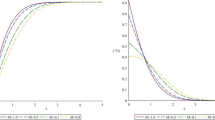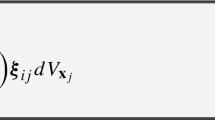Abstract
This paper presents a novel nonlocal numerical paradigm for a class of general nonlinear ordinary differential equations using the peridynamic differential operator. Differential governing equations and initial/boundary conditions are reformulated from the local differential form to the nonlocal integral form using a meshless orthogonal technique. The solution domain is partitioned into a finite number of points, of which the properties are obtained through weighted summation over the corresponding properties of neighboring points. Using the Lagrange multiplier method and the variational principle, nonlinear ordinary differential equations with initial/boundary conditions can be solved through the Newton–Raphson iteration method. Moreover, the differences between the proposed method and other methods are illustrated by comparing several impact factors. Furthermore, three benchmarks, including the Riccati equation, the Poisson equation, and the fluid flow equation, have been solved to show the applicability and accuracy of the proposed numerical method, and the results are consistent with the numerical results in the previous literature. Finally, the proposed method is applied to the galloping vibration problem to reveal the galloping mechanism.












Similar content being viewed by others
References
Chinviriyasit S, Chinviriyasit W (2010) Numerical modelling of an SIR epidemic model with diffusion. Appl Math Comput 216:395–409
Bender CM, Orszag S, Orszag, SA (1999) Advanced mathematical methods for scientists and engineers I: asymptotic methods and perturbation theory, vol 1. Springer Science & Business Media
Xu DH, Xu YH, GE MB, Zhang QF (2021) Models and numerics for differential equations and inverse problems. Science Press, Beijing
Kim MS, Cha D, Lee KM, Lee HJ, Kim T, Lee C (2020) Modeling of ozone decomposition, oxidant exposures, and the abatement of micropollutants during ozonation processes. Water Res 169:115230
Marzban HR, Hoseini SM, Razzaghi M (2009) Solution of Volterra’s population model via block-pulse functions and Lagrange-interpolating polynomials. Math Methods Appl Sci 32:127–134
Slavyanov SY, Shat’ko DA, Ishkhanyan AM, Rotinyan TA (2016) Generation and removal of apparent singularities in linear ordinary differential equations with polynomial coefficients. Theor Math Phys 189:371–379
Babadzanjanz LK, Bolshakov AI (2012) Implementation of the Taylor series method for solving ordinary differential equations. Vychislitel’nye metody i programmirovanie: novye vychislitel’nye tekhnologii technology 13:497–510
Zingg DW, Chisholm TT (1999) Runge–Kutta methods for linear ordinary differential equations. Appl Numer Math 31:227–238
Shokri A, Neta B, Mehdizadeh KM, Rashidi MM, Mohammad-Sedighi H (2021) A singularly P-stable multi-derivative predictor method for the numerical solution of second-order ordinary differential equations. Mathematics 9(8):806
Lyakhov DA, Gerdt VP, Michels DL (2019) On the algorithmic linearizability of nonlinear ordinary differential equations. J Symb Comput 98:3–22
Wang YK, Ni GY, Liu YC (2020) Multistep Newton–Picard method for nonlinear differential equations. J Guid Control Dyn 43:2148–2155
Abd El Salam MA, Ramadan MA, Nassar MA, Agarwal P, Chu YM (2021) Matrix computational collocation approach based on rational Chebyshev functions for nonlinear differential equations. Adv Differ Equ 2021(1):1–17
Ebaid A, Wazwaz AM, Alali E, Masaedeh BS (2017) Hypergeometric series solution to a class of second-order boundary value problems via Laplace transform with applications to nanofluids. Commun Theor Phys 67:231–234
Swaidan W, Ali HS (2021) Numerical solutions for linear ordinary differential equation with variable coefficients using Haar wavelet method. J Interdiscip Math 24:1811–1824
Casetta L (2016) A theorem on energy integrals for linear second-order ordinary differential equations with variable coefficients. Appl Math Lett 51:8–12
Ridha ZD, Mohommed FA (2021) Solving linear ordinary differential equations by using Shehu transform with variable coefficients. J Interdiscip Math 24:2391–2400
Altay N, Demiralp M (2010) Numerical solution of ordinary differential equations by Fluctuationlessness theorem. J Math Chem 47:1323–1343
Aida-Zade KR, Kuliev SZ (2011) Numerical solution of nonlinear inverse coefficient problems for ordinary differential equations. Comput Math Math Phys 51:803–815
Silling SA (2000) Reformulation of elasticity theory for discontinuities and long-range forces. J Mech Phys Solids 48:175–209
Cheng ZQ, Sui ZB, Yin H, Yuan CF, Chu LS (2019) Studies of dynamic fracture in functionally graded materials using peridynamic modeling with composite weighted bond. Theor Appl Fract Mech 103:102242
Jafarzadeh S, Chen ZG, Li SM, Bobaru F (2019) A peridynamic mechano-chemical damage model for stress-assisted corrosion. Electrochim Acta 323
Qi J, Li C, Tie Y, Zheng Y, Cui Z, Duan Y (2022) An ordinary state-based peridynamic computational investigation of fiber-reinforced composites. Comput Part Mech 1–15
Silling SA, Barr C, Cooper M, Lechman J, Bufford DC (2021) Inelastic peridynamic model for molecular crystal particles. Comput Part Mech 8:1005–1017
Silling SA, Parks ML, Kamm JR, Weckner O, Rassaian M (2017) Modeling shockwaves and impact phenomena with Eulerian peridynamics. Int J Impact Eng 107:47–57
Javili A, Morasata R, Oterkus E, Oterkus S (2019) Peridynamics review. Math Mech Solids 24:3714–3739
Madenci E, Barut A, Futch M (2016) Peridynamic differential operator and its applications. Comput Methods Appl Mech Eng 304:408–451
Madenci E, Barut A, Dorduncu M (2019) Peridynamic differential operator for numerical analysis, vol 10. Springer International Publishing, Berlin, pp 978–3
Bazazzadeh S, Shojaei A, Zaccariotto M, Galvanetto U (2019) Application of the peridynamic differential operator to the solution of sloshing problems in tanks. Eng Comput 36:45–83
Li ZY, Huang D, Xu YP, Yan KH (2021) Nonlocal steady-state thermoelastic analysis of functionally graded materials by using peridynamic differential operator. Appl Math Model 93:294–313
Li Z, Huang D, Yan K, Xu Y (2022) Large deformation analysis of functionally graded beam with variable cross-section by using peridynamic differential operator. Compost Struct 279:114788
Gao Y, Oterkus, S (2020) Multi-phase fluid flow simulation by using peridynamic differential operator. Ocean Eng 216
Chang H, Chen A, Kareem A, Hu L, Ma R (2022) Peridynamic differential operator-based Eulerian particle method for 2D internal flows. Comput Methods Appl Mech Eng 392:114568
Pala Y (2017) An analytical method for solving general Riccati equation. Univ J Appl Math 5(2):11–16
Prasad V, Kulacki FA (1984) Natural-convection in a vertical porous annulus. Int J Heat Mass Transf 27:207–219
Parand K, Delafkar Z, Baharifard F (2011) Rational Chebyshev Tau method for solving natural convection of Darcian fluid about a vertical full cone embedded in porous media whit a prescribed wall temperature. World Acad Sci Eng Technol Int J Math Comput Phys Electr Comput Eng 5:1186–1191
Hartog JPD (1932) Transmission line vibration due to sleet. Trans Am Inst Electr Eng 51:1074–1076
Acknowledgements
This work was supported by Shanghai Pujiang Program [Grant Number 22PJD079].
Author information
Authors and Affiliations
Corresponding author
Ethics declarations
Conflict of interest
The authors declare that there is no conflict of interest in this paper.
Additional information
Publisher's Note
Springer Nature remains neutral with regard to jurisdictional claims in published maps and institutional affiliations.
Rights and permissions
Springer Nature or its licensor (e.g. a society or other partner) holds exclusive rights to this article under a publishing agreement with the author(s) or other rightsholder(s); author self-archiving of the accepted manuscript version of this article is solely governed by the terms of such publishing agreement and applicable law.
About this article
Cite this article
Yu, X., Chen, A. & Chang, H. Peridynamic differential operator-based nonlocal numerical paradigm for a class of nonlinear differential equations. Comp. Part. Mech. 10, 1383–1395 (2023). https://doi.org/10.1007/s40571-023-00568-z
Received:
Revised:
Accepted:
Published:
Issue Date:
DOI: https://doi.org/10.1007/s40571-023-00568-z
Keywords
- Peridynamic differential operator
- Nonlinear ordinary differential equations
- The Riccati equation
- The Poisson equation
- The fluid flow equation
- The galloping equation




